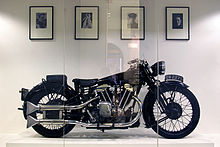George Brough
George Brough [bʀaːv] (born April 21, 1890 - January 12, 1970 ) was a British motorcycle manufacturer , motorcycle racer and world record holder . He was known for his elaborate, handcrafted Brough Superior sports motorcycles, which were the world's fastest motorcycles in the late 1920s and 1930s.
In 1921 Brough began to build motorcycles, which soon made a name for themselves among connoisseurs for their excellent craftsmanship. For many motorcycle connoisseurs in the 1920s and 1930s, a George Brough motorcycle was the equivalent of a Rolls-Royce in automobiles - or better: it was more comparable to Bentleys because of its sporting suitability .
In 1928 George Brough drove in Arpajon on a machine with a performance-enhanced JAP built -in engine of well over 70 hp at a speed of 130.6 mph (approx. 214 km / h), the world's fastest speed on a conventionally powered solo motorcycle until then.
The type designations of his motorcycles indicated the guaranteed achievable top speed in miles: the side valve controlled SS 80 should run a good 80 miles an hour, and the head-controlled top models of the SS100 should be faster than 100 miles an hour. It is not known that any of its customers ever needed Broughs warranty - the machines were, without exception, faster than the type specifications.
One of Brough's best customers was the famous Arabia fighter TE Lawrence , who in the last twelve years of his life bought seven new motorcycles from George Brough, named them all "George" and numbered them to distinguish them (George I, George II, etc.).
In his second book "The Mint", which is essentially about his career in the Royal Air Force , Lawrence described a spontaneous race between him on his SS 100 on the country road and a sports airplane pilot, which ended in a draw and both participants were great Gave pleasure.
TE Lawrence wrote a personal letter to George Brough in 1932, in which he thanked Brough and his staff for the perfectly tuned new machine - the last he bought - and praised the motorcycle in the highest tones. TE Lawrence was then killed on this Brough Superior named "George VII", a model SS100 (Super Sport) in 1935 during an evasive maneuver on a country road. (This motorcycle is now restored and is currently on loan at the Imperial War Museum in London.)
With a few exceptions, George Brough used only built-in motors from JA Prestwich in London (JAP) until 1934, always emphasizing that these motors were specially manufactured for him according to his specifications. From 1935 onwards, however, the 1000 cc models were supplied with Matchless engines, apparently because JAP was no longer willing to accommodate George Brough's wishes. The most powerful of his series motorcycles was the 1934 SS100 model with the famous JAP "two-of-everything" engine (so named because the V-2-cylinder engine had two separate carburettors and two magneto ignition units). The power of this engine was 75 hp. However, only about ten copies of this model were built.
Between 1936 and 1939 George Brough also built a small number of exclusive automobiles.
With the beginning of the Second World War , motorcycle production was largely stopped as the company was assigned manufacturing tasks for armaments purposes. A sidecar machine designed by George Brough for military use was not commissioned by the English Ministry of Defense; instead, precision parts for aircraft engines were produced. The last motorcycle left the factory on July 2, 1940.
After the end of the war, motorcycle production should be resumed, but George Brough could no longer get engines suitable for his machines. His last development, the "Golden Dream" model with its own transverse 4-cylinder boxer engine and cardan drive, turned out to be so expensive to manufacture that it was no longer possible in a market that was dominated by large numbers of industrially manufactured motorcycles was yours. George Brough operated a production of mechanical precision parts until the 1960s and continued to look after his customers' motorcycles.
George Brough died on January 12, 1970 at the age of 79, but his motorcycles are still alive. The Brough Superior Club, founded in 1958, brings together more than 300 owners of these motorcycles who not only exhibit their machines, but also move them on their own axles over many hundreds of kilometers at meetings in England and other European countries.
Sources and web links
- George Brough on the Isle of Man TT official website.
- http://www.classicfighters.co.nz/ac/brough/index.shtml
- http://www.firstworldwar.com/poetsandprose/lawrencete.htm
| personal data | |
|---|---|
| SURNAME | Brough, George |
| BRIEF DESCRIPTION | British pilot, motorcycle racer, world record holder, motorcycle maker, writer and actor |
| DATE OF BIRTH | April 21, 1890 |
| DATE OF DEATH | January 12, 1970 |
